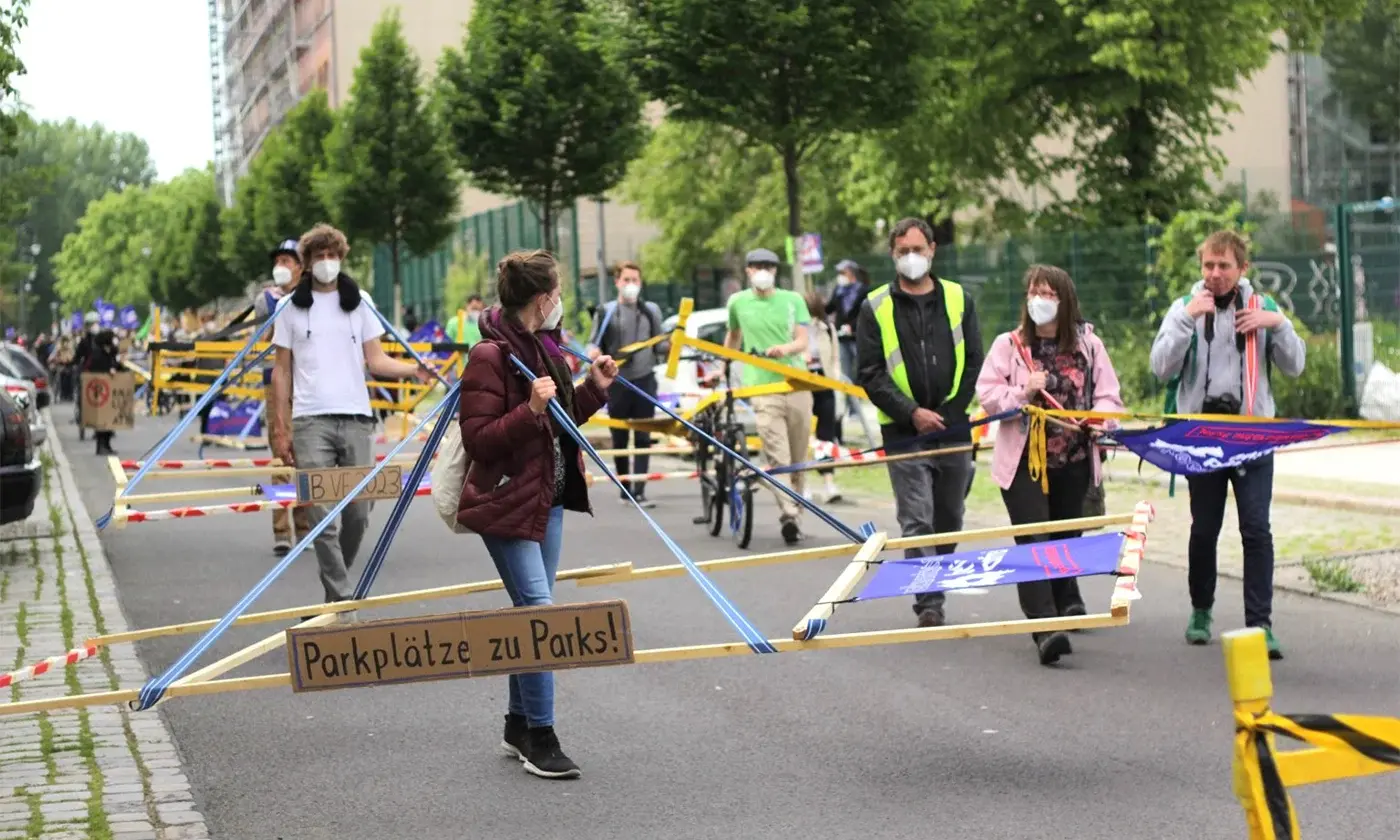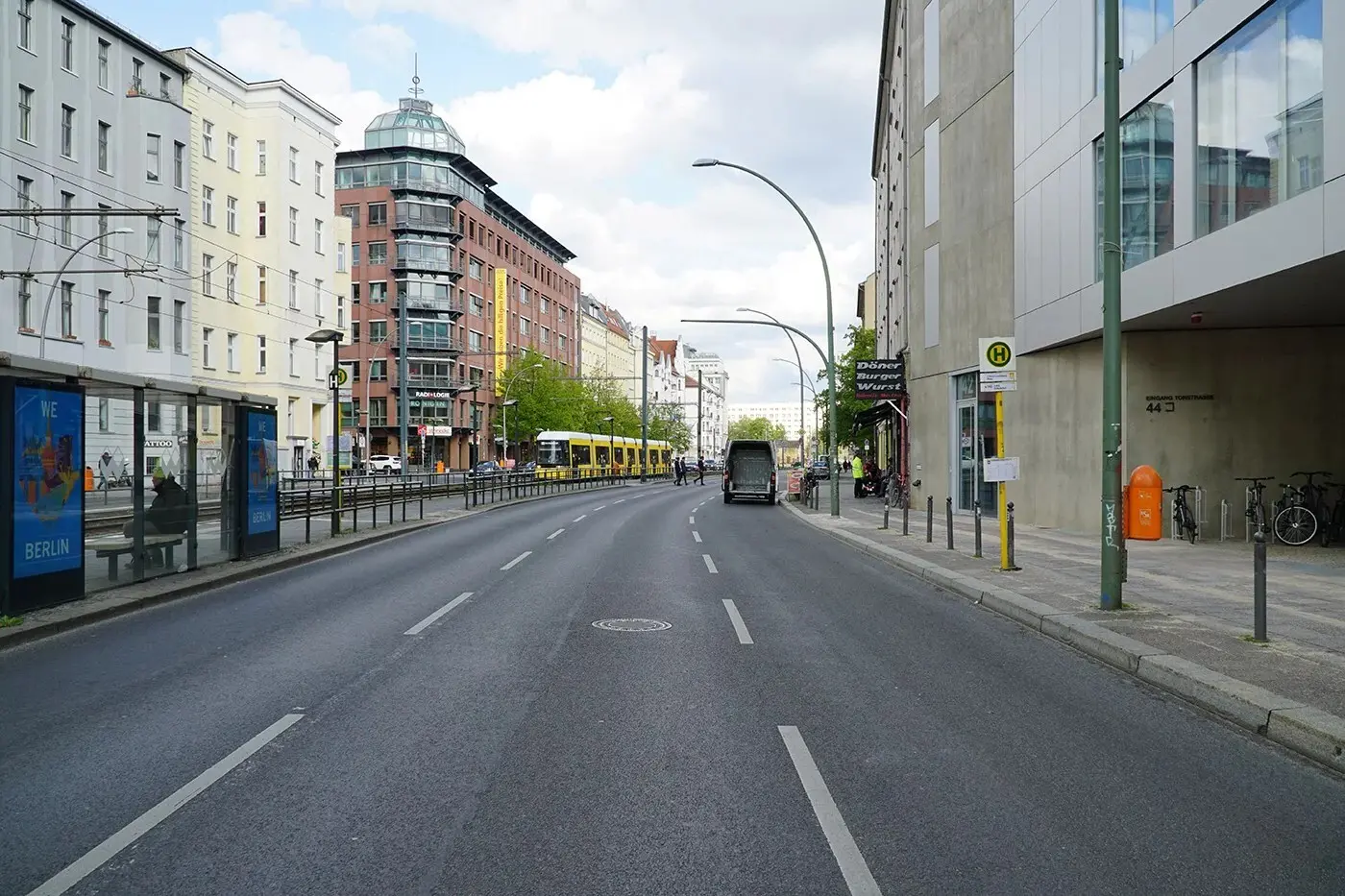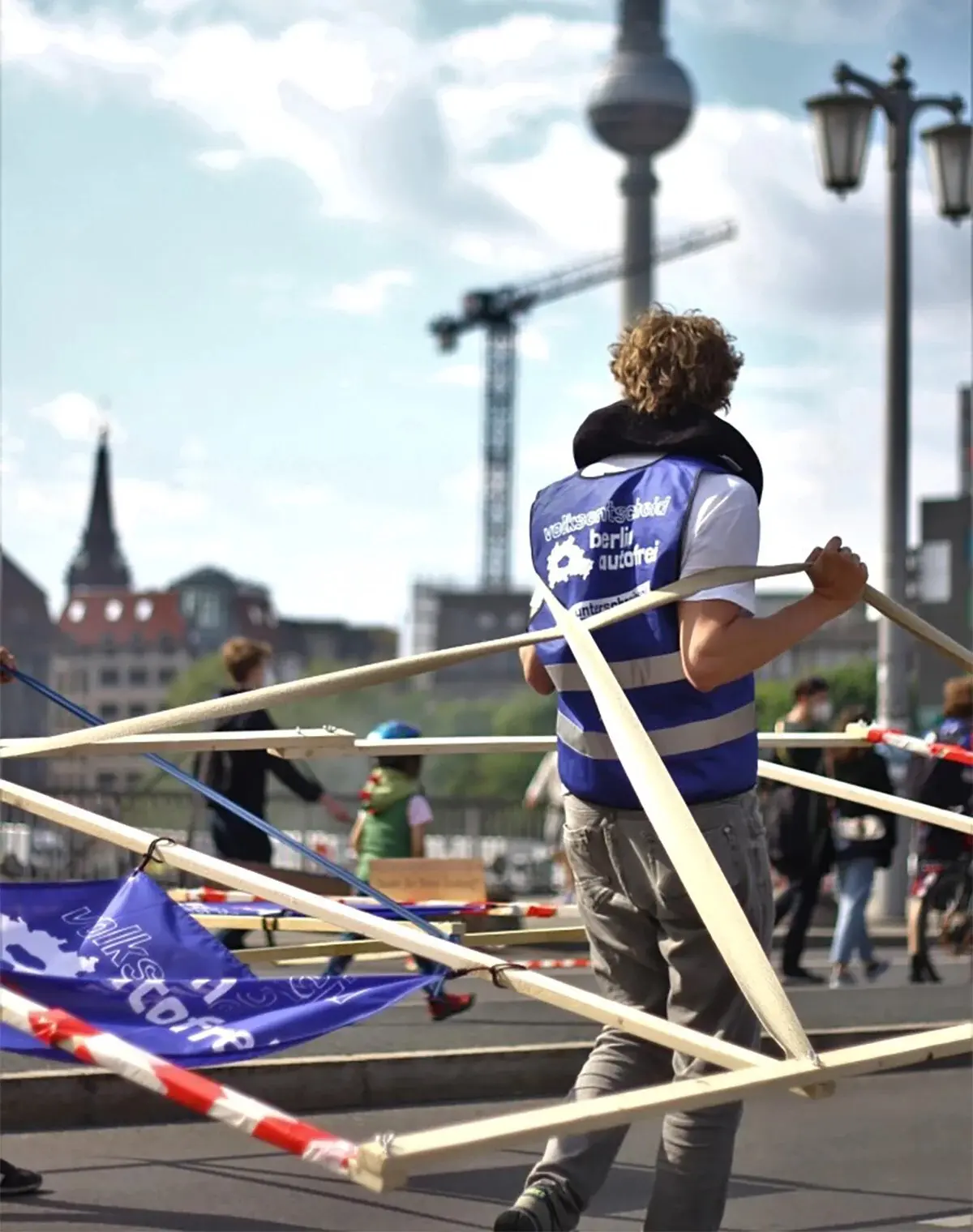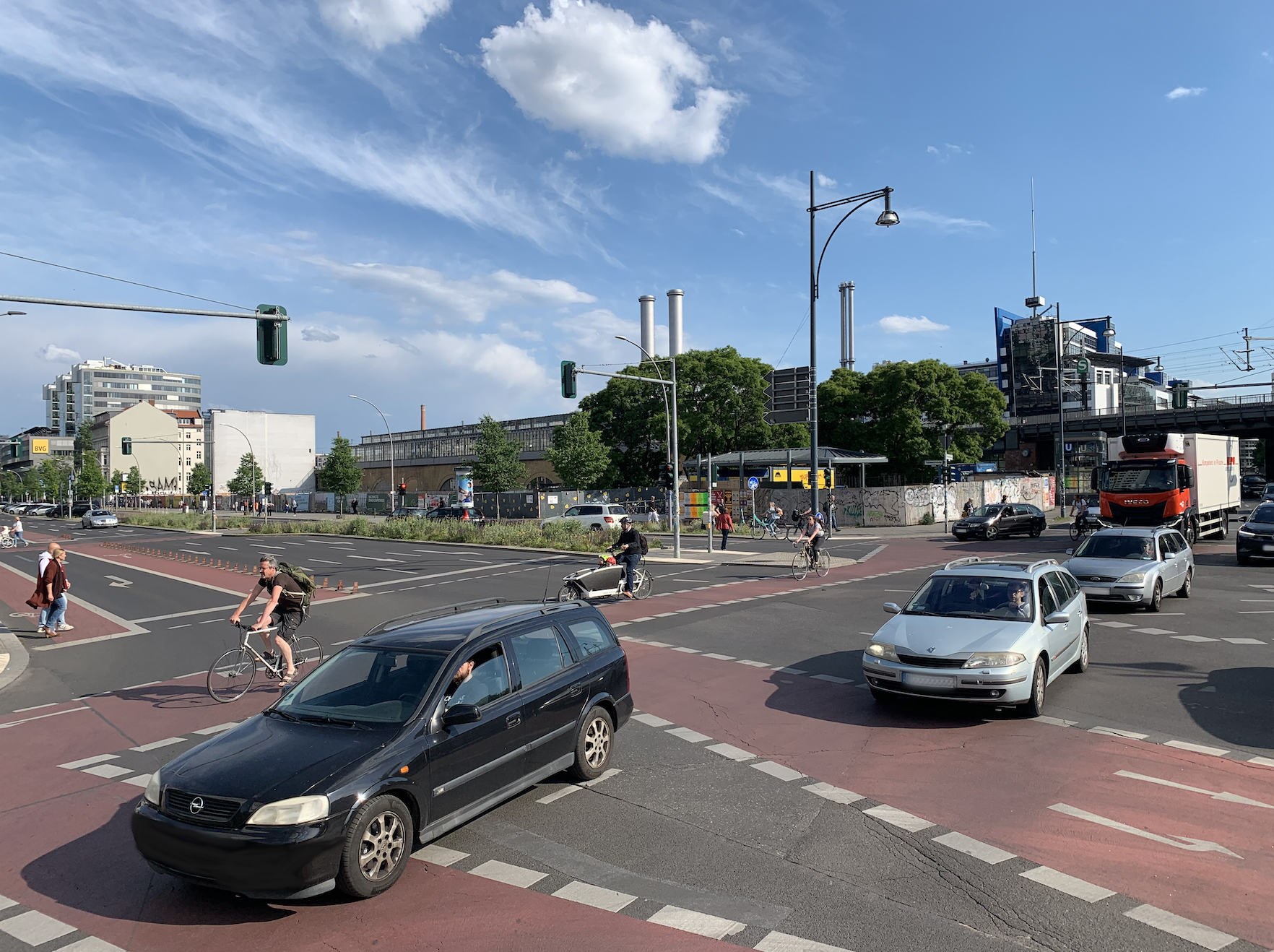
An initiative to make the city car-free is prompting a larger dialogue around equity in urban design.
In car-centric Berlin, a downtown apartment situated between two U-Bahn subway lines should be a transit rider’s paradise. However, for mother and Berlin resident Alina Hamer, the prime location of her residence is overshadowed by the subway’s inaccessibility. She has avoided using either subway station for the past four years. One lacks an elevator and has incredibly steep stairs, she says. “It wouldn’t be possible—it wouldn’t be safe—to carry a baby carriage and a baby down or up those stairs.” The other station does have an elevator, she says, but “it very reliably breaks over the weekend.”
Hamer’s experience in accessing public transportation as a woman and a caretaker is not uncommon. Data suggests that many transit systems do not meet the needs of all travelers, and that the inequities are often gendered.
In 2021, for example, global architecture and engineering consultancy firm Ramboll published a study of seven capital cities around the world, including Berlin, and found that women use public transportation more often than men, who instead use private cars at a higher rate. Unsurprisingly, these cities were often designed to accommodate cars, and so while most residents don’t actually own a car or travel by car, the vehicles are the central element around which the rest of the city and its activities are organized.
Gender also shows up in spatial patterns of travel around the city. Those who identify as women in Germany are disproportionately responsible for unpaid care work, including for elderly family members. The burden of running errands—grocery shopping, bringing children to school, etc.—often falls on their shoulders, too. So while men are more likely to travel in the form of one long trip, from home to work, women are more likely to combine multiple, shorter trips to run errands en route—like day care drop-off, dry cleaning pickup, groceries, or pharmacy runs—and they more often use public transportation to accomplish these tasks.
Travel patterns are also influenced by occupational status, which is similarly gendered. In Germany, more employed women work part time (58% in 2019) than full time (42%). In two-parent, heterosexual households, 68% of men work full time while their partners work part time, whereas only 2% of men work part time while their female counterparts work full time.
One solution being advocated to address this gender inequity is upgrading public transport to make it everyone’s primary mode of transport—not just those who identify as women or caretakers. Volksentscheid Berlin Autofrei, or “Car-Free Referendum Berlin,” is a grassroots organization looking to alter the way all Berliners travel in the city core by converting the space currently occupied by parked and traveling cars into dedicated space for pedestrians and bikes.
The Autofrei initiative argues that going car-free would increase accessible urban amenities and green public space in the heart of the city. It is also prompting a larger dialogue around inequities in urban design. “Gender and urban space is something that is way less discussed here in Germany,” says gender researcher and historian Hannah Lotte Lund, “so raising awareness would be very helpful.”

Fewer Cars, More Benefits
The Autofrei initiative proposes the city’s first car-free zone. Personal vehicles would no longer be allowed in the portion of Berlin’s aboveground subway system that rings the city center. Taxis, ambulances, delivery trucks, and commercial vehicles would still be allowed to travel freely in this zone. Residents with limited mobility would be exempt from the ban on cars, and all other residents would have 12 exemptions per year for occasions when a car is particularly useful, such as moving, going on vacation, etc.
In addition, anyone whose gender identity puts them in disproportionate danger by exclusively riding public transportation could be considered for a full-time exemption. For example, if trans women feel that using public transportation unnecessarily puts them at risk of gender-based violence, they could apply for an exemption.
The Autofrei initiative argues that reduced car travel would lead to increased safety, better health, greater climate protection, and all-around higher quality of life in Berlin.
Cars pose safety issues for bicyclists, especially caretakers. German law states that children under 8 years old are required to bike on the sidewalk, but adults must ride in road-adjacent bike lanes. Hamer observes many parents riding on the sidewalk with their kids, and says, “Honestly, that’s probably what I’m going to be doing, because I cannot imagine having my 4-to-5-year-old on his own on the sidewalk.”
When talking about cycling infrastructure, mobility strategist Lena Osswald said in an email, “It is important to build a close-knit network that feels safe to use for people with different ages, different experiences, and different daily schedules. This is the opposite of building extremely expensive cycling speedways next to motorways to allow faster commuting to paid labor.”
But how could safety be transformed if the role of the sidewalk was reimagined altogether?
“The sidewalk is only there to separate the people from the cars,” says mobility innovation consultant Lieke Ypma. “So if there were no cars, everything could be one level.” Curbs would no longer limit travel between the street and the sidewalk.
“People with walking help or a wheelchair could be more independent to go where they need to go,” Ypma says. A future city with fewer cars—or no cars at all—would create greater independence through accessibility. And those improvements would benefit everybody.
Investing in a Car-Free Future
While Berlin’s car-free dream may read as utopian, it is not a novel concept.
Paris Mayor Anne Hidalgo expects to reduce traffic by 55% as part of her initiative to eliminate all nonessential car travel in 5.4 square miles of the city by 2024. Boston, Massachusetts, holds temporary street closures to allow local businesses to expand from storefronts to sidewalks during summertime. Oslo achieved zero pedestrian and cycling deaths in 2019, largely thanks to car-free sections of the city.
Barcelona’s ongoing “superblocks” project seeks to eliminate car travel in certain intersections that lie within its gridded, residential streets. Scientists found that in a neighborhood that had been converted into a superblock, air quality increased as byproducts from the burning of fuel decreased: Nitrous dioxide levels decreased by 25%, and particulate matter (PM10) levels decreased by 17%. Residents noticed the increase in accessibility for strollers and wheelchair users, too; 60% of residents surveyed felt safer walking in the newly converted streets.
In Berlin in 2020, the senate approved a plan that would allot €28.1 billion toward new train and tram cars, expanded routes, and improvements to existing infrastructure. But in order for the Autofrei initiative to succeed, local and national governments would need to make even more robust investments in public transportation, so more commutes can be accomplished by public transit. However, investment in the transportation system cannot just be financial; the transport sector as a whole must commit to the inclusion of diverse perspectives.

Inclusive Infrastructure
“If you want to have representation of the mobility needs and patterns in the planning and in the politics,” says Autofrei’s spokesperson Lisa Buchmann, “you also need female and other marginalized groups inthe planning and in the politics.”
That’s what drives the research of Osswald and her colleague, Ann-Kathrin Bersch. In their 2021 discussion paper hypothesizing why these gender gaps exist in transit, they found a critical knowledge gap on gender disparities not only in mobility research, but also in implementation by civil engineers and city planners. And those gaps exist both in Germany and beyond.
“Mobility policies and especially built infrastructures are still not built in a way that fits all. A big part of that stems from the fact that we as a society see engineering as an impartial field. “It is not,” Osswald says. “It builds reality and impacts daily routines of people.”
Traffic engineering is (in Germany) mainly carried out by men, so Osswald says it’s important to actively support the careers of people with different genders and backgrounds in traffic engineering and mobility policies so they can help bring more perspectives into the planning process and overcome biases.
Osswald points to multiple factors that could help make transit more gender-inclusive (not to mention climate-friendly): implementing gender impact assessments of built infrastructure, integrating interdisciplinary approaches in planning processes, and just generally talking more about how built infrastructure will affect users.
She says everyone who plans, builds, or uses them should understand what it means to build infrastructure for all. While a fortified public transport infrastructure provides greater freedom for women and caretakers, this change has the potential to positively affect all Berliners.
“If cars are banned, public transport will automatically be prioritized, meaning more trains, scheduled at tighter intervals,” Ypma says. Everyone benefits from having timely and predictable transit, but she emphasizes that “punctuality is twice as important for people who care for kids, on their way to work and on their way home to pick up kids from day care.”
A Question of Freedom
In May of 2022, the Berlin senate ruled the car-free referendum unconstitutional, claiming that Autofrei’s draft law disproportionately restricts freedom of action. The current draft is now awaiting legal assessment under the state constitutional court.
“We are confident that if we went to the highest court of the constitution, we would win,” Buchmann says.“Our claim to reduce car travel in Berlin is not only proportionate but absolutely necessary.”
Supporters of Autofrei, she says, believe their referendum promotes more freedom of movement within the city, not less. Most importantly, the passage of Autofrei could be the singular push needed to change Berlin from a car-centric city to a public-transit-centered one.
While Autofrei eventually expects victory in the courts, the bureaucratic process could drag on for another year before Berliners have the opportunity to voice their opinions on the ballot. Whether Autofrei’s visions come to fruition or not, the process to make Berlin equally livable for all its residents requires both citizens and politicians alike to be on board.
In the meantime, continuing to advocate for gender-specific solutions in transport may be the first step. Lund urges activists like those in Autofrei to stay forward-looking: “Most of all, inform people; give them an example that things can be changed, inform people what can be done and what new ways of thinking are out there.”











